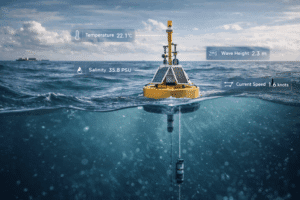This article will discuss environmental monitoring for the outdoor environment including air, water, noise, and biodiversity.
What Is Environmental Monitoring?
Environmental monitoring is composed of tools and techniques that identify, analyze, and establish parameters for environmental conditions to quantifiably assess the impacts from various activities on the environment. It is based on different test and assessment techniques which provide key information about the environment and possible risk levels.
Environmental monitoring allows pollution levels to be controlled and trends to be identified.
Your environmental monitoring at your fingertips!
Optimize your environmental monitoring, become smarter and more sustainable with a unified system that gathers all your environmental sensors & data in one place.

What Is the Purpose of Environmental Monitoring?
Environmental monitoring helps to understand and study the complexity of the environment in relation to polluting events like industrial activity.
Companies and organizations must show that they have implemented set actions and control systems to monitor their environmental impact on the local environment. The goal is to understand and reduce impacts, comply with environmental regulations, and conserve environmental and human health.
When preparing an environmental impact assessment (ESA), which evaluates the negative impacts and effects of a future project on the surrounding environment, companies must use advanced environmental monitoring technology. Environmental monitoring is thus essential to begin business operations.
The parameters of environmental monitoring indicate how the environment is responding to surrounding activities.
Environmental monitoring can be done in real-time or using sampling methods. As the world digitalizes, the trend is to use real-time monitoring systems. Real-time environmental monitoring software, like that of the Sinay Hub, allows simple and quick assessment with key environmental indicators that allow accurate decision-making. With the help of advanced AI (Artificial Intelligence) algorithms, environmental monitoring can show key indicators in real-time so that organizations understand the direct impact of their activities. Indicators can include pollutants in the air, turbidity in water, noise levels, etc.
As the world consumes more energy each year, environmental monitoring systems are a turning point to reduce environmental impact, save the planet, protect public exposure to pollutants, and cut costs.
Four Types of Environmental Monitoring
At Sinay, we identified four types of environmental monitoring: air quality, water quality, noise quality, and biodiversity.
Environmental Monitoring of Air
Air pollutants harm human health and environmental health. As air quality is essential to human health and national air quality government regulations must be followed by businesses and organizations. Air quality can be monitored in real-time by connecting software to sensors located in an area of choice. These sensors then measure levels and report main pollutants in the air; for instance, particulate matter, nitrogen dioxide, carbon monoxide, sulfur dioxide, and ozone. Air quality can also be measured manually with stations that collect air particles for a period of time before being measured.

Environmental Monitoring of Water
All bodies of water must be monitored, as water is essential to life on earth. Water must be clean, drinkable, safe, and sanitary. Bodies of water must also be clean so that marine life and biodiversity can thrive. Water can be measured in real-time by connecting software to sensors located in bodies of water. These sensors then can communicate when thresholds are reached; for example, dissolved oxygen, turbidity, bioindicators, nitrates, pH, chemical contamination, and water temperature. Water samples can also be collected manually then sent to a lab.
Click here to discover why monitoring water quality is important
Click here to discover what are the main indicators of water quality
Environmental Monitoring of Noise
Noise can be monitored both for sea life and on land. In the sea, cetaceans use noises as we use our eyes. For example, if there is too much noise pollution whales cannot communicate which puts them in danger. On land, noise can disrupt wildlife’s natural habitats and the quality of life for humans.
To measure sound in the sea and on land, software connects to sensors that report real-time noise levels. Noise level thresholds are set and determined beforehand so organizations know how much noise can be made.
Noise monitoring in the sea protects sea life and on land protects communities close to industrial sites, such as ports and airports.
Sinay is currently in the process of developing our underwater noise monitoring software and aerial noise monitoring software.

Environmental Monitoring of Biodiversity
Biodiversity is the presence of the population of species on earth. Climate change continues to reduce plant and animal biodiversity. Biomonitoring shows directly how our activities are impacting the environment due to biodiversity reactions. Diverse types of animal and plant species are monitored for a period of time to develop an analysis of how activities may be affecting them.
Sinay is currently developing a SeaLife Module that will use artificial intelligence to identify varied species of sea life for biomonitoring.
Why Is Environmental Monitoring Important?
Environmental monitoring of water, air, noise, and biodiversity allows businesses to identify and analyze environmental conditions and assess their impact on the environment. Clean air and water, noise pollution reduction, and biomonitoring are essential to life on earth. With many government regulations already in place and more passing each year, company management must monitor their long- and short-term environmental impact to stay in business and start new projects. This also helps to gain public support. Environmental monitoring is more important now than ever before, especially after the IPCC report released stating the health of our climate is in severe danger if we do not change our actions – the search for drastically helping our environment has started.
The more we monitor the environment, the more environmental monitoring systems can then be improved. For example, systems in which machine learning (ML) is used learn over time, and the more data they have the better they can forecast new predictions and ecosystem development. This then allows organizations to determine if surrounding environments are improving or degrading.
Environmental monitoring is the way of the future.
Frequently Asked Questions About: ENVIRONMENTAL MONITORING
An environmental monitoring system is a process that monitors the quality of the environment. The system is often an application that uses data and AI to produce key indicators. Click here to discover Sinay’s environmental monitoring systems.
Air, Water, Noise, and Biodiversity
Environmental monitoring programs are in fact associated with food safety. Click here to read more.
Monitoring water quality is an example of environmental monitoring since you are tracking and measuring the pollutants in the water.



